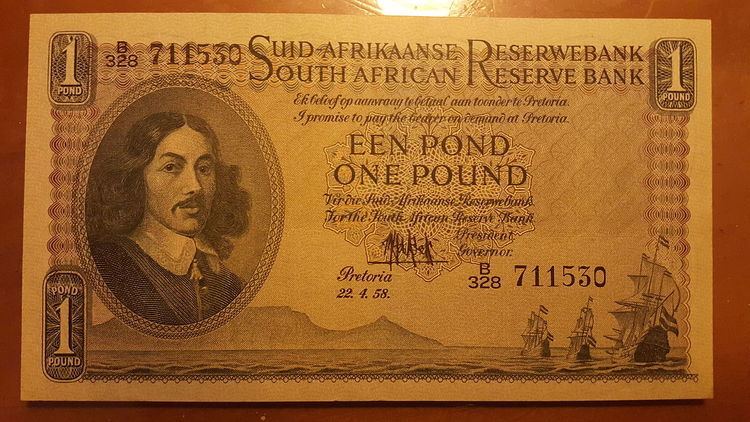Plural pond (Afrikaans only) Symbol £ | shilling s | |
 | ||
The pound (symbol £) was the currency of the Union of South Africa from the creation of the country as a British Dominion in 1910. It was replaced by the rand in 1961, the same year that South Africa became a republic.
Contents
In 1825, an imperial order-in-council made sterling coinage legal tender in all the British colonies. At that time, the only British colony in Southern Africa was the Cape of Good Hope Colony. As time went on, the British pound sterling and its associated subsidiary coinage became the currency of every British territory in Southern Africa. The pound at that time was subdivided into 20 shillings, each of 12 pence.
History
The pound sterling became the standard currency of the Cape of Good Hope colony in 1825 following an imperial order-in-council that was issued for the purpose of introducing the sterling coinage into all the British colonies. British coins then replaced the Dutch currency. Before a unified South Africa, many authorities issued coins and banknotes in their own pound, equivalent to sterling.
The Transvaal Republic, the Boer state that in 1902 was to become Transvaal Colony, issued notes from 1867 to 1902 and coins from 1892 to 1902. The gold coins were denominated in pond rather than pounds.
In 1920, the Treasury issued gold certificate notes. The following year, the South African Reserve Bank was established as the sole note issuing authority. Coins were issued from 1923. The South African pound remained equal to the pound sterling throughout its existence, except for a short period following the abandonment of the gold standard in the United Kingdom in 1931. When the United Kingdom abandoned the gold standard in September 1931, Canada quickly followed suit because it had been under exactly the same pressure as the United Kingdom. The contraction of the money supply in the United States had been causing large amounts of gold bullion to flow west across the Atlantic Ocean, and south into the United States. The situation in South Africa was different, because gold exportation to London was a major business. According to Jan Smuts in his biography, the Nationalists specifically wanted to make a point of not automatically following suit with the United Kingdom, and they perceived that they were in a strong position to do so. For the United Kingdom and Canada, an outflow of gold was seen as a flight of gold, whereas for South Africa the same was seen as a profitable enterprise. The effect of South Africa's continuing adherence to the gold standard did not however turn out as Hertzog might have hoped. The South African pound rose dramatically in value against the pound sterling, and this virtually crippled South Africa's gold export industry overnight. By 1933, Hertzog abandoned the gold standard and the South African pound returned to parity with the pound sterling. The relief was felt almost immediately.
The South African pound was replaced by the rand on 14 February 1961 at a rate of 2 rand = 1 pound. That rate continued until the Sterling devaluation in 1967 when South Africa did not follow suit.
Strachan and Co currency (S&Co) tokens
The first Strachan tokens were issued without holes. None of these were ever found and the denominations are not known. Later Strachan tokens were issued in 3d, 6d, 1/- and 2/- and are South Africa's first widely circulating indigenous currency.
The son of Donald Strachan, Douglas Strachan, notes the S&Co tokens were issued not long after 1870 In this same diary note Douglas Strachan notes that the S&Co tokens were "accepted everywhere". The area of circulation from the stores at Umzimkhulu quickly spread to a large area including Kokstad about 100 km to the south. Although not evidence based,Ken Strachan, Douglas Strachan's son, told Scott Balson in the late 1970s that the S&Co tokens were launched on the day the company opened its doors in 1874.
The Griqua Council do not mention the tokens at all before or during the council meeting in January 1875, so it is possible that they were issued after this date.
In 1874 the area known as East Griqualand was an independent state run by the Griqua and one of the directors of Strachan and Co, Brisley, was the state's parliamentary secretary. The fact that the S&Co tokens were circulated is confirmed by the Standard Bank in Kokstad.
The S&Co token preceded the Kruger coinage by eighteen years making them the first indigenous British currency based coins widely used in South Africa.
Transvaal Republic
Eighteen years later, in 1892, the Transvaal Republic introduced coins in denominations of 1, 3 and 6 pence, 1, 2, 2½ and 5 shillings, ½ and 1 pond(pound). The last of these coins were issued in 1900, except for siege 1 pond coins issued in 1902.
Union of South Africa
The Union of South Africa issued coins from 1923, in denominations of ¼, ½, 1, 3 and 6 pence, 1, 2 (initially denominated as a florin) and 2½ shillings, ½ and 1 sovereign. The coins were the same weights as the corresponding British coins but the silver coins (3 pence up to 2½ shillings) were struck in .800 fineness silver. Gold coins were struck until 1932.
In 1947, 5 shilling coins were introduced, with occasional commemorative variants. In 1951, the silver coinage switched to .500 fineness. Gold bullion ½ and 1 pound coins were issued from 1952 in the same specifications as the ½ and 1 sovereign.
All the coins had the British monarch on the obverse, with the titles in Latin, while the reverse had the denomination and "South Africa" written in English and Afrikaans.
